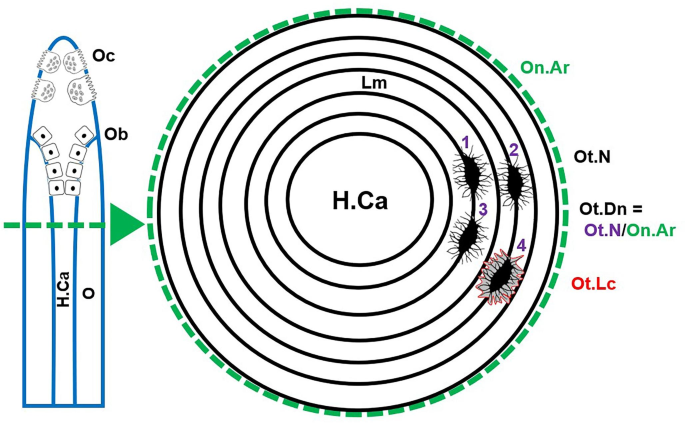Rib remodelling changes with body size in fossil hippopotamuses from Cyprus and Greece
IF 2.1
3区 生物学
Q2 ZOOLOGY
引用次数: 0
Abstract
Abstract Large species that are isolated for thousands of years on islands often evolve extreme degrees of dwarfism. Very little is known about physiological processes that accompany such extreme transitions in extinct dwarf species. We tested whether physiological cycles of bone maintenance (remodelling) in dwarf adult hippopotamuses correlate with insularity-driven body mass shifts that may occur due to variables such as ecological release from predation pressure and change in access to resources. We hypothesised that hippopotamuses with the smallest body size should show higher values of osteocyte lacunae, proxies for osteoblast proliferation during cycles of remodelling, when compared to relatively larger dwarf forms, as well as much larger mainland common hippopotamuses. We examined 20 ribs from three extinct Pleistocene Hippopotamus species spanning a gradient in body size: H. minor (~132 kg, Cyprus), H. creutzburgi (~398 kg, Crete), and H. antiquus (~3200 kg, mainland Greece). Ribs were selected because they reflect bone metabolic rates that are not completely clouded by factors such as biomechanics. Densities of osteocyte lacunae (Ot.Dn) were examined in 864 individual secondary osteons observed in histology sections. We found the highest average Ot.Dn in the H. minor ribs, intermediate Ot.Dn in the H. creutzburgi ribs, and the lowest Ot.Dn in the H. antiquus ribs. It appears that Ot.Dn distinctly separated these three species, possibly signifying a gradient in bone remodelling such that bone tissue optimises maintenance in the face of insularity-driven reduction of body size. We discuss hippopotamus rib bone microstructure and the utility of Ot.Dn in palaeontological analyses for elucidating intricate biological processes occurring in bone of insular fossil mammals.

塞浦路斯和希腊河马化石的肋骨重塑随体型变化
在岛屿上被隔离了数千年的大型物种经常进化成极端程度的侏儒症。在已灭绝的矮种中,伴随这种极端转变的生理过程所知甚少。我们测试了成年侏儒河马骨骼维持(重塑)的生理周期是否与孤岛驱动的体重变化相关,这种体重变化可能是由于捕食压力和获取资源的变化等变量引起的。我们假设,与相对较大的侏儒形式以及更大的大陆普通河马相比,体型最小的河马应该显示出更高的骨细胞腔隙值,这代表了在重塑周期中成骨细胞的增殖。我们研究了三种已灭绝的更新世河马的20根肋骨,它们的体型分布不同:H. minor (~132 kg,塞浦路斯)、H. creutzburgi (~398 kg,克里特岛)和H. antiquus (~3200 kg,希腊大陆)。选择肋骨是因为它们反映的骨代谢率不完全受生物力学等因素的影响。对864例继发性骨进行了骨细胞腔隙(Ot.Dn)密度检测。我们找到了最高的平均值。h小肋中有Dn,中间有Ot。在H. creutzburgi肋骨中有Dn;在H.古肋骨中。看来奥。Dn将这三个物种区分开来,这可能意味着骨骼重塑的梯度,使得骨组织在面对岛屿驱动的体型缩小时能够优化维护。我们讨论了河马肋骨的微观结构和Ot的应用。在古生物学分析中阐明发生在岛状化石哺乳动物骨骼中的复杂生物过程。
本文章由计算机程序翻译,如有差异,请以英文原文为准。
求助全文
约1分钟内获得全文
求助全文
来源期刊

Journal of Mammalian Evolution
ZOOLOGY-
CiteScore
4.30
自引率
10.50%
发文量
45
审稿时长
>12 weeks
期刊介绍:
Journal of Mammalian Evolution is a multidisciplinary forum devoted to studies on the comparative morphology, molecular biology, paleobiology, genetics, developmental and reproductive biology, biogeography, systematics, ethology and ecology, and population dynamics of mammals and the ways that these diverse data can be analyzed for the reconstruction of mammalian evolution. The journal publishes high-quality peer-reviewed original articles and reviews derived from both laboratory and field studies. The journal serves as an international forum to facilitate communication among researchers in the multiple fields that contribute to our understanding of mammalian evolutionary biology.
 求助内容:
求助内容: 应助结果提醒方式:
应助结果提醒方式:


